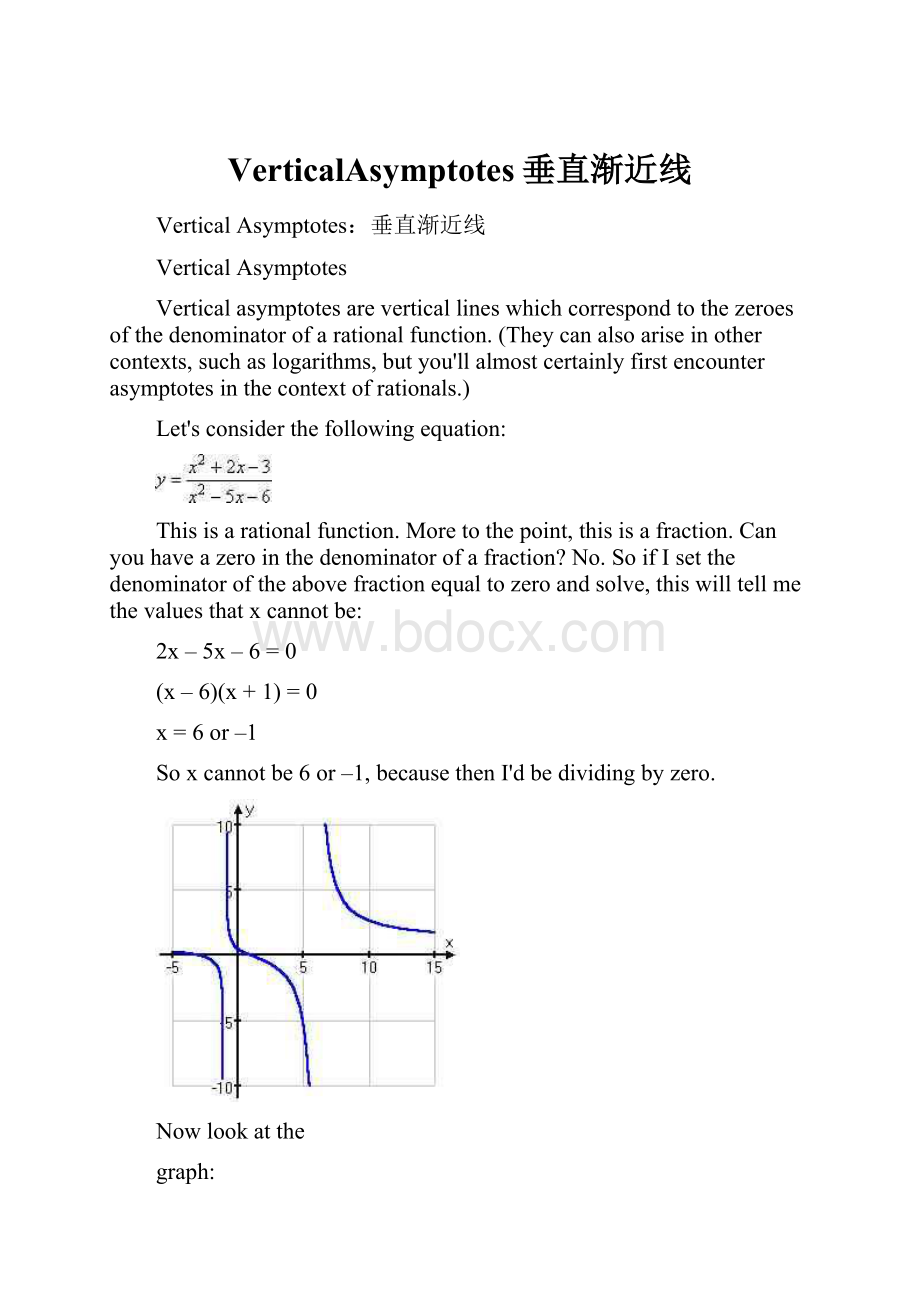VerticalAsymptotes垂直渐近线.docx
《VerticalAsymptotes垂直渐近线.docx》由会员分享,可在线阅读,更多相关《VerticalAsymptotes垂直渐近线.docx(16页珍藏版)》请在冰豆网上搜索。

VerticalAsymptotes垂直渐近线
VerticalAsymptotes:
垂直渐近线
VerticalAsymptotes
Verticalasymptotesareverticallineswhichcorrespondtothezeroesofthedenominatorofarationalfunction.(Theycanalsoariseinothercontexts,suchaslogarithms,butyou'llalmostcertainlyfirstencounterasymptotesinthecontextofrationals.)
Let'sconsiderthefollowingequation:
Thisisarationalfunction.Moretothepoint,thisisafraction.Canyouhaveazerointhedenominatorofafraction?
No.SoifIsetthedenominatoroftheabovefractionequaltozeroandsolve,thiswilltellmethevaluesthatxcannotbe:
2x–5x–6=0
(x–6)(x+1)=0
x=6or–1
Soxcannotbe6or–1,becausethenI'dbedividingbyzero.
Nowlookatthe
graph:
Youcanseehowthegraphavoidedtheverticallinesx=6andx
=–1.Thisavoidanceoccurredbecausexcannotbe–1or6.In
otherwords,thefactthatthefunction'sdomainisrestrictedis
reflectedinthefunction'sgraph.Moreusefully,youcanusethe
domaintohelpyougraph,becausewhichevervaluesarenot
allowedinthedomainwillbeverticalasymptotesonthegraph.
Youcandrawthevertical
asymptoteasadashedlineto
remindyounottographthere,
likethis:
(It'salrightthatthegraph
appearstoclimbrightupthe
sidesoftheasymptoteonthe
left.Thisiscommon.Aslongas
youdon'tdrawthegraph
crossingtheverticalasymptote,
you'llbefine.)
Let'sreviewthisrelationshipbetweenthedomainandtheverticalasymptotes.
Findthedomainandverticalasymptotes(s),ifany,of
thefollowingfunction:
Thedomainisthesetofallx-valuesthatI'mallowedtouse.
Theonlyvaluesthatcouldbedisallowedarethosethat
givemeazerointhedenominator.SoI'llsetthe
denominatorequaltozeroandsolve.
2x+2x–8=0
(x+4)(x–2)=0
x=–4orx=2
SinceIcan'thaveazerointhedenominator,thenIcan't
havex=–4orx=2inthedomain.Thistellsmethatthe
verticalasymptotes(whichtellmewherethegraphcannot
go)willbeatthevaluesx=–4orx=2.
domain:
verticalasymptotes:
x=–4,2
Notethatthedomainandverticalasymptotesare"opposites".Theverticalasymptotesareat–4and2,andthedomainis
everywherebut–4and2.Thisisalwaystrue.
Findthedomainandverticalasymptote(s),ifany,ofthefollowingfunction:
Tofindthedomainandverticalasymptotes,I'llsetthedenominatorequaltozeroandsolve.Thesolutionswillbethevaluesthatarenotallowedinthedomain,andwillalsobetheverticalasymptotes.
2x+9=0
2x=–9
Oops!
Thatdoesn'tsolve!
Sotherearenozeroesinthedenominator.Sincetherearenozeroesinthedenominator,thentherearenoforbiddenx-values,andthedomainis"all
x".Also,sincetherearenovaluesforbiddentothedomain,therearenoverticalasymptotes.
domain:
allx
verticalasymptotes:
none
Noteagainhowthedomainandverticalasymptoteswere
"opposites"ofeachother.
Findthedomainandverticalasymptote(s),ifany,of
thefollowingfunction:
I'llcheckthezeroesofthedenominator:
2x+5x+6=0
(x+3)(x+2)=0
x=–3orx=–2
SinceIcan'tdividebyzero,thenIhaveverticalasymptotes
atx=–3andx=–2,andthedomainisallotherx-values.
domain:
verticalasymptotes:
x=–3andx=–2
Whengraphing,rememberthatverticalasymptotesstandforx-
valuesthatarenotallowed.Verticalasymptotesaresacredground.Never,onpainofdeath,canyoucrossaverticalasymptote.Don'teventry!
Whereasverticalasymptotesaresacredground,horizontalasymptotesarejustusefulsuggestions.Whereasyoucannevertouchaverticalasymptote,youcan(andoftendo)touchandevencrosshorizontalasymptotes.Whereasverticalasymptotesindicateveryspecificbehavior(onthegraph),usuallyclosetotheorigin,horizontalasymptotesindicategeneralbehaviorfarofftothesidesofthegraph.Togettheideaofhorizontalasymptotes,let'slooksatsomesimpleexamples.
Findthehorizontalasymptoteofthefollowingfunction:
Thehorizontalasymptotetellsme,roughly,wherethegraphwillgowhenxisreally,reallybig.SoI'lllookatsomeverybigvaluesforx,somevaluesofxveryfarfromthe
origin:
x
–100000–0.0000099...
–10000–0.0000999...
–1000–0.0009979...
–100–0.0097990...
–10–0.0792079...
–10.5
02
11.5
100.1188118...
1000.0101989...
10000.0010019...
100000.0001000...
1000000.0000100...
Offtothesidesofthegraph,wherexisstronglynegative(suchas–1,000)orstronglypositive(suchas10000),the
"+2"andthe"+1"intheexpressionforyreallydon'tmattersomuch.Iendeduphavingareallybignumberdividedby
areallybignumbersquared,which"simplified"tobeavery
smallnumber.They-valuecamemostlyfromthe"x"and
222the"x".Andsincethexwas"bigger"thanthex,thex
draggedthewholefractiondowntoy=0(thatis,thex-axis)
whenxgotbig.
Icansee
this
behavior
onthe
graph:
Thegraphshowssomeslightlyinterestingbehaviorinthemiddle,neartheorigin,buttherestofthegraphisfairlyboring,trailingalongthex-axis.
IfIzoominontheorigin,Icanalsoseethatthegraphcrossesthehorizontalasymptote
(Itiscommonandperfectlyokaytocrossahorizontalasymptote.It'stheverticalasymptotesthatI'mnotallowedtotouch.)
AsIcanseeinthetableofvaluesandthegraph,thehorizontalasymptoteisthex-axis.
horizontalasymptote:
y=0(thex-axis)
Intheaboveexercise,thedegreeonthedenominator(namely,2)
wasbiggerthanthedegreeonthenumerator(namely,1),and
thehorizontalasymptotewasy=0(thex-axis).
Thispropertyisalwaystrue:
Ifthedegreeonxinthe
denominatorislargerthanthedegreeonxinthenumerator,
thenthedenominator,being"stronger",pullsthefractiondowntothex-axiswhenxgetsbig.Thatis,ifthepolynomialinthedenominatorhasabiggerleadingexponentthanthepolynomialinthenumerator,thenthegraphtrailsalongthex-axisatthefar
rightandthefarleftofthegraph.
Whathappensifthedegreesarethesameinthenumeratoranddenominator?
Findthehorizontalasymptoteofthefollowing:
Unlikethepreviousexample,thisfunctionhasdegree-2
polynomialstopandbottom;inparticular,thedegreesarethesameinthenumeratorandthedenominator.Sincethedegreesarethesame,thenumeratoranddenominator"pull"evenly;thisgraphshouldnotdragdowntothex-axis,norshoulditshootoff
toinfinity.Butwherewillitgo?
Again,Ineedtothinkintermsofbigvaluesforx.Whenxis
reallybig,I'llhave,roughly,twicesomethingbig(minusaneleven)dividedbyoncesomethingbig(plusanine).Asyou
mightguessfromthelastexercise,the"–11"andthe"+9"won't
mattermuchforreallybigvaluesofx.Farofftothesidesofthe
22graph,I'llroughlyhave"2x/x",whichreducestojust2.Doesa
tableofvaluesbearthisout?
Let'scheck:
x
–1000001.9999999...
–100001.9999997...
–10001.9999710...
–1001.9971026...
–101.7339449...
–1–0.9
0–1.2222222...
1–0.9
101.7339449...
1001.9971026...
10001.9999710...
100001.9999997...
1000001.9999999...
Forbigvaluesofx,thegraphis,asexpected,verycloseto
y=2.
Thegraph
reflectsthis:
Thenmyansweris:
horizontalasymptote:
y=2
Intheexampleabove,thedegreesonthenumeratoranddenominatorwerethesame,andthehorizontalasymptoteturnedouttobethehorizontallinewhosey-valuewasequalto
thevaluefoundbydividingtheleadingcoefficientsofthetwopolynomials.Thisisalwaystrue:
Whenthedegreesofthenumeratorandthedenominatorarethesame,thenthehorizontalasymptoteisfoundbydividingtheleadingterms,sotheasymptoteisgivenby:
y=(numerator'sleadingcoefficient)/(denominator's
leadingcoefficient)
Whathappensifthedegreeisgreaterinthenumeratorthaninthedenominator?
Reasonably,thenumerator,being"stronger",oughtto"pull"thegraphawayfromthex-axis(y=0)oranyother
fixedy-value.
Toinvestigate,lookatthefollowingtable.Inthecolumntotheleftofthefirstgraph,youcanseetheoriginalfunction,theoriginalfunctionafterrearrangementbylongdivision,andthe
polynomial-onlypartoftheoriginalfunction.Thenlookatthesecondgraphinthesametable,andnotethesimilaritybetweenthegraphoftheoriginalfunctionandthegraphofthepolynomialpartofthefunction.
originalgraphoftheoriginal
function:
function:
longdivision:
rearranged
function:
graphofpolynomialpart:
polynomialpart:
y=–3x–3
Notethe
similarity
betweenthe
twographs.
Exceptfor
wherethe
vertical
asymptote
causesabreak
inthemiddle,
thetwographs
arepractically
thesame,as
youcansee
fromthe
overlay.
Thegraphsshowthat,ifthedegreeofthenumeratorisexactly
onemorethanthedegreeofthedenominator(sothatthe
polynomialfractionis"improper"),thenthegraphoftherationalfunctionwillbe,roughly,aslant-ystraightlinewithsomefiddlybitsinthemiddle.Becausethegraphwillbenearlyequaltothisslantedstraight-lineequivalent,theasymptoteforthissortofrationalfunctioniscalleda"slant"(or"oblique")asymptote.Theequationfortheslantasymptoteisthepolynomialpartoftherationalthatyougetafterdoingthelongdivision
(Bytheway,thisrelationship--betweenanimproperrationalfunction,itsassociatedpolynomial,andtheirgraphs--holdstrue
regardlessofthedifferenceinthedegreesofthenumeratoranddenominator.)
Findtheslantas